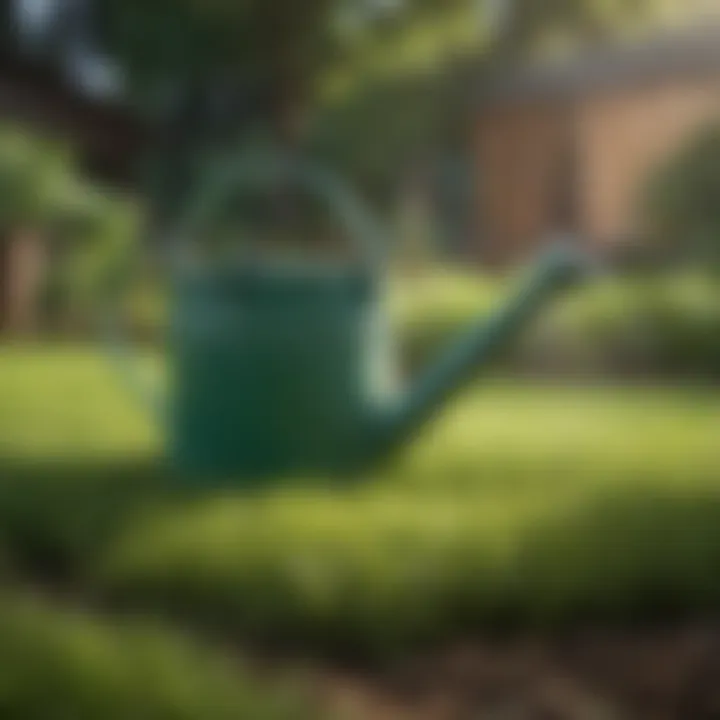How to Cultivate a Lush, Green Lawn


Intro
Creating a lush, green lawn is a goal for many homeowners and gardening aficionados. It goes beyond just having a place to relax; a thick lawn enhances the visual appeal of a property, providing an inviting atmosphere. However, achieving this vision requires a solid understanding of foundational practices. Each step in the process, from soil preparation to ongoing maintenance, plays a crucial role in ensuring that your lawn thrives.
This article offers a coherent and thorough guide to growing a thick green lawn while addressing common hurdles that might arise along the way. Expect to discover valuable techniques and tips that can transform your yard into a vibrant oasis. You will find insights into soil quality, watering methods, seasonal care, and more. By the end of this guide, you will be equipped with the knowledge needed to cultivate a resilient and attractive lawn with minimal effort.
Intro to Growing a Thick Green Lawn
Creating a lush and vibrant lawn is a goal for many homeowners. A thick green lawn not only enhances curb appeal but also provides numerous benefits for the environment and personal enjoyment. Understanding the process of establishing and maintaining such a lawn is essential. This article delves into the intricacies of growing a thick green lawn, highlighting varied practices that can lead to success.
Importance of Lawn Quality
The quality of your lawn reflects your care and commitment to home aesthetics. A healthy, thick lawn can increase property value and create a welcoming atmosphere for guests. Additionally, such lawns can help filter pollutants, control erosion, and provide a habitat for local wildlife. A well-kept lawn also plays a role in cooling the environment, promoting a sustainable ecosystem.
Moreover, a high-quality lawn contributes to outdoor activities, providing an ideal space for family gatherings or relaxation. Many homeowners find that investing time and resources into lawn care pays off with substantial returns, both in visual appeal and functionality. Lawn quality is not merely about beauty; it impacts the overall environment positively.
Setting Realistic Expectations for Lawn Growth
When embarking on your journey to grow a thick green lawn, it’s crucial to set realistic expectations. Lawn growth is influenced by several factors, including grass species, soil conditions, weather, and maintenance practices.
Nurturing a lawn takes time, and results may not appear immediately. It’s vital to understand the growth cycles and seasonal characteristics of your chosen grass species. For instance, cool-season grasses thrive in spring and fall, while warm-season grasses flourish in summer. Additionally, the local climate will determine the ideal times for planting and maintenance.
Patience is necessary as seed germination and establishment require several weeks. Be ready to adapt your strategies based on observed progress. Evaluate your lawn’s health routinely and make adjustments as needed. Remember, persistence is key in the quest for a thick, green lawn.
Understanding Your Lawn Environment
Understanding your lawn environment is crucial for developing a thick and lush green lawn. Every lawn exists within a specific set of conditions, including climate and soil quality. These elements directly affect grass growth, health, and resilience, which is why assessing your lawn's environment should be one of the first steps in achieving your gardening goals.
Climate Considerations
Climate plays a significant role in determining the type of grass that will flourish in your yard. Different grasses have varying tolerances to temperature, humidity, and sunlight. For instance, cool-season grasses like Kentucky bluegrass thrive in northern climates, where temperatures are cooler in spring and fall. On the other hand, warm-season grasses like Bermudagrass prefer warmer temperatures and are ideal for southern regions.
In addition to temperature, understanding rainfall patterns is essential. Areas with high rainfall might require different management strategies compared to drier regions. Knowing your local climate will help you choose the right grass species and implement appropriate care techniques.
Soil Type and Quality
Soil is the foundation of your lawn. Understanding its type and quality can lead to better growth and health.
Identifying Soil Composition
Identifying soil composition means understanding the percentage of sand, silt, and clay in your soil. Sandy soils drain well but may lack nutrients. Clay soils retain moisture but can become compacted. Knowing your soil type allows you to amend it appropriately. For example, sandy soils might benefit from organic matter that improves nutrient retention, whereas clay soils often need aeration.
Soil pH Testing
Soil pH testing measures the acidity or alkalinity of your soil. Most grasses grow best in soils with a pH between 6 and 7.5. Testing your soil pH can indicate whether you need to add lime to raise the pH or sulfur to lower it. Adjusting soil pH is crucial for nutrient availability and overall lawn health.
Improving Soil Structure
Improving soil structure involves modifying the composition and physical qualities of your soil. This can include adding organic matter, like compost, which enhances aeration and drainage. Improved soil structure leads to better root development and contributes to a thicker lawn. Thus, focusing on soil structure is not just beneficial; it is essential for achieving a healthy, resilient lawn.
Remember: Understanding your lawn environment gives you the roadmap needed to cultivate a thick, green lawn. Each step you take to improve your soil and adapt to your climate will lead to healthier grass and a more vibrant lawn.
Choosing the Right Grass Species
Selecting the appropriate type of grass is critical for establishing a thick green lawn. This choice significantly impacts the lawn's overall health, aesthetic, and resilience to environmental challenges. Different grass species possess unique characteristics that affect their growth rates, maintenance requirements, and adaptability to various climates. Notably, the right grass can enhance the lawn's visual appeal and its ability to withstand wear and tear.
Grass Varieties for Different Climates
Cool-Season Grasses
Cool-season grasses grow best in the cooler months of spring and fall. They thrive when temperatures range between 60 and 75 degrees Fahrenheit, making them suitable for northern climates. One of the most noteworthy characteristics of cool-season grasses is their capacity for quick recovery. They are known for their lush, dense foliage that establishes a vibrant green lawn quickly. Popular varieties include Kentucky Bluegrass and Tall Fescue.


The significant advantage here is their ability to grow actively when temperatures start to drop after a hot summer. However, during the peak summer heat, they can become dormant, resulting in a brownish appearance until cooler weather returns. This could be a disadvantage for homeowners seeking a consistently lush lawn year-round.
Warm-Season Grasses
Warm-season grasses, on the other hand, exhibit optimal growth during warmer months, specifically between 80 and 95 degrees Fahrenheit. Varieties like Bermuda Grass and Zoysia Grass are favored in southern climates. A key characteristic of warm-season grasses is their extensive root systems. This makes them drought-tolerant and capable of thriving in less favorable conditions, like dry summers.
The ability to withstand higher temperatures offers a considerable advantage for homeowners living in warmer regions. However, warm-season grasses can suffer during colder months, becoming dormant and leaving the lawn brown and lifeless in winter. This periodic dormancy necessitates careful planning for appearance and maintenance.
Evaluating Grass Performance and Aesthetics
When choosing grass species, evaluating both performance and aesthetics is vital for achieving your desired lawn. Factors like growth rate, color, texture, and tolerance to foot traffic must be considered. Some grasses provide vibrant colors and a plush texture, enhancing the lawn's appeal. Homeowners should prioritize species that not only look good but also thrive under local environmental conditions.
In summary, the choice of grass species is not a mere formality but a cornerstone in achieving a dense, resilient lawn. Making the right decision requires understanding the local climate and matching it with the characteristics of different grass varieties.
Preparing the Soil
Preparing the soil is a critical step in growing a thick, green lawn. It ensures that the grass has a solid foundation to grow vigorously. Soil preparation involves multiple processes aimed at enhancing soil quality and structure. Good soil supports root development, retains moisture, and provides essential nutrients for healthy grass growth. Neglecting this vital phase can lead to poor grass performance and an uneven lawn, ultimately hindering your efforts.
Clearing Existing Vegetation
One of the first tasks in soil preparation is clearing any existing vegetation. This involves removing weeds, grass, and any other plants that may compete for nutrients and space. Weeds can hinder grass growth by stealing resources, so effective removal is essential. Tools like shovels, hoes, or herbicides can be used to eliminate unwanted plants. However, care should be taken when using chemicals to avoid harming the future lawn.
Amending the Soil
Amending the soil means enriching it with materials that improve its structure and nutrient content.
Adding Organic Matter
Adding organic matter is a popular practice when preparing soil for grass. Organic materials like compost or aged manure significantly enhance soil texture and fertility. They increase microbial activity, which contributes to healthier soil ecosystems. These materials also improve moisture retention, making water available to grass roots. However, one should note that it may take time for these amendments to break down and fully benefit the soil.
Utilizing Fertilizers
Utilizing fertilizers is another strategy to amend soil. Fertilizers provide essential nutrients that grass needs for growth. They can come in forms such as granular or liquid, and choosing the correct type depends on the specific nutrient needs of your soil. Fertilizers can yield quick results, improving lawn health. However, improper use might lead to nutrient runoff, which can affect the environment negatively. Balance and understanding of your lawn's specific requirements are necessary.
Tilling and Leveling the Ground
Finally, tilling and leveling the ground complete the preparation process. Tilling breaks up compacted soil, enhancing air circulation and root penetration. This encourages a stronger lawn. Leveling the ground helps create an even surface, preventing water from pooling in low spots and ensuring effective drainage. A well-prepared and level garden bed is the foundation for a thriving lawn.
Seeding Techniques for a Dense Lawn
Seeding techniques play a critical role in establishing a thick and lush lawn. Proper seeding not only ensures uniform growth but also promotes healthier grass. The methods you choose for sowing will have long-term impacts on your lawn's density, appearance, and resilience against stressors. This section will explore two primary methods of seed application and considerations related to optimal seeding rates and timing.
Seed Selection and Sowing Methods
Broadcast Seeding
Broadcast seeding is a widely used method for sowing grass seed over a large area. In this approach, the seeds are scattered evenly across the prepared soil surface. One key characteristic of broadcast seeding is its simplicity. Gardeners can quickly cover larger plots without requiring specialized equipment. This method is particularly beneficial for homeowners looking to establish a lawn in a straightforward manner.
However, broadcast seeding does have its drawbacks. If not done properly, seeds may not be evenly distributed, resulting in patchy growth. Additionally, seeds are more exposed to birds and other wildlife, which may consume them before germination occurs. Despite these potential issues, the ease of use and speed of this method often make it a popular choice among those looking to achieve a dense lawn.
Using a Seeder
Using a seeder can enhance the efficiency and accuracy of the seeding process. This method involves applying seeds using a device that spaces them uniformly. The main characteristic of a seeder is its ability to deliver seeds at consistent rates and depths, which can significantly improve germination rates. Homeowners who are keen on achieving a dense lawn will find this method beneficial since it reduces the chances of overcrowding or under-planting.
One unique feature of using a seeder is its adaptability to various seed types and sizes, making it versatile for different grass varieties. This method does require an investment in the machinery, which could be a consideration for some. However, the trade-off is often worth it for those serious about lawn aesthetics, as it minimizes labor time and ensures an even spread.
Optimal Seeding Rates and Timing
For successful growth, understanding the right seeding rates and timing is essential. Over-seeding can lead to competition for resources, while under-seeding can result in bare patches. A general rule is to follow the recommended guidelines based on the specific grass type you choose. Timing is also crucial; sowing during optimal seasons—typically spring or fall—will ensure better seed germination and root establishment.
Proper timing and rate selection can exponentially increase the chances of having a thick green lawn.
Watering Strategies for Lawn Growth


Watering is a fundamental component of nurturing a thick, green lawn. This topic is crucial as it directly influences grass health and overall lawn aesthetics. Proper watering promotes deep root growth, encourages vigorous grass development, and supports resilience against pests and diseases. Understanding the right strategies ensures that your lawn receives the appropriate amount of hydration while minimizing waste and environmental impact.
Understanding Water Needs of Grass
Different grass species have varying water requirements. Generally, grass needs about one inch of water per week, either through rainfall or irrigation. Factors like soil type, weather conditions, and the stage of grass growth can influence these needs. For instance, a newly seeded lawn might need more frequent watering until it is fully established. Conversely, established lawns can often tolerate longer intervals between waterings. Monitoring your lawn’s appearance is key. If the grass blades appear bluish or leave footprints when you walk on them, it is likely thirsty.
Irrigation Techniques
Effective irrigation is necessary for ensuring that grass receives uniform and adequate water. There are several methods to choose from, with each having its unique benefits depending on your lawn’s layout, climate, and personal preference.
Drip Irrigation Systems
Drip irrigation systems deliver water directly to the plant’s root zone through a network of tubing and emitters. This method reduces evaporation and water runoff, making it efficient. The main characteristic of drip systems is their ability to provide consistent moisture at a slow rate, promoting healthy root development.
A unique feature of drip irrigation is its adaptability; it can precisely water specific areas of your lawn or garden, reducing waste in spots that do not need as much water. However, initial costs and installation complexity might deter some homeowners. Regular maintenance is also necessary to clear any clogs in the emitters.
Manual Watering
Manual watering involves using a hose or a watering can. This method offers total control over how much water is applied and when. Homeowners often find this personal touch beneficial because it allows for assessing the lawn's needs directly. The key characteristic here is flexibility; you can water specific areas that show signs of drought or stress.
The unique advantage of manual watering is that it enables a more hands-on approach to lawn care. Yet, it can be time-consuming and impractical for larger lawns. Furthermore, inconsistency in application might lead to over-watering or under-watering, thus impacting lawn health negatively.
Creating a Watering Schedule
A well-structured watering schedule is essential to maintaining a thick green lawn. It should account for local weather patterns, soil moisture levels, and grass species. Watering in the early morning is often the best choice, as this allows the grass to absorb moisture before the heat of the day causes evaporation.
In summary:
- Monitor grass needs: Regularly check the lawn's appearance for indications of stress.
- Adjust your schedule: Be flexible according to rain forecasts and temperature changes.
- Use targeted techniques: Consider irrigation methods that fit your lifestyle and lawn size.
Implementing thoughtful watering strategies will significantly enhance your lawn's health and sustainability.
Maintaining Your Lawn
Maintaining your lawn is a crucial part of ensuring its health, density, and overall appearance. Regular maintenance enables grass to thrive, providing an aesthetic that increases property value and enhances outdoor enjoyment. This section will cover three important aspects: mowing practices, fertilization schedules, and weed and pest management.
Mowing Practices
Optimal Mowing Height
The optimal mowing height plays a big role in the health of your lawn. Grass should generally be kept between two and four inches high, depending on the species. Taller grass has deeper roots, which helps it withstand periods of drought. Cut it too short, and you risk exposing the roots, which can lead to damage and stress.
A key characteristic of optimal mowing height is its impact on photosynthesis. Grass blades need a sufficient area to absorb sunlight. Mowing at the right height promotes rich green blades and reduces weed competition. Most homeowners benefit from adhering to this height range, as it leads to a healthier lawn overall. However, if the height is not maintained properly, issues like scalping can arise, leading to bare patches.
Frequency of Mowing
Mowing frequency is another important aspect of lawn maintenance. Ideally, you should mow your lawn once a week during the growing season. This keeps the grass healthy and allows for a uniform look. Frequent mowing promotes lateral growth, making the lawn denser over time. It helps avoid overgrowth that may require cutting too much grass in one go.
It's also essential to adjust your mowing frequency based on growth rates. For example, after a rain, grasses may grow faster, warranting increased frequency. Alternatively, during drought, mowing can be less frequent. This practice helps in maintaining optimal health for the grass.
Fertilization Schedules
Understanding NPK Ratios
Understanding NPK ratios is vital for your lawn’s nutrition. NPK stands for nitrogen, phosphorus, and potassium, three key nutrients that grass needs to thrive. A balanced ratio tailored to your specific lawn needs ensures healthy growth and resilience against stressors.
For instance, a common ratio for starters is 10-10-10, which provides an even distribution of nutrients. This kind of ratio is useful for general lawn maintenance. However, based on your soil test results, adjusting the ratio may be necessary. Incorrect NPK ratios can lead to unhealthy grass, increased susceptibility to pests and diseases.
Choosing Organic or Synthetic Fertilizers
When selecting fertilizers, you have the option between organic and synthetic types. Organic fertilizers, derived from natural sources, release nutrients gradually and improve soil structure over time. They are beneficial for long-term health of the lawn as they also support beneficial microorganisms.
On the other hand, synthetic fertilizers offer a quick nutrient boost. They are often cheaper and more accessible. However, they have potential drawbacks, such as causing nutrient leaching into water systems. Choosing between these options depends on your specific lawn goals and balance between immediate results and long-term health.


Weed and Pest Management
Identifying Common Weeds
Identifying common weeds is crucial to maintaining lawn health. Weeds compete with grass for nutrients and water; knowing what they look like helps in effective management. Common types like dandelions or crabgrass can be persistent and may require targeted approaches.
Being able to recognize these plants means you can address them before they spread. Early identification allows for proper treatment, whether through manual removal or using herbicides. It’s an essential step in maintaining a vigorous lawn, as unchecked weeds can significantly detract from your lawn's visual appeal.
Integrated Pest Management Techniques
Integrated pest management is a comprehensive strategy to control pests effectively. This approach combines biological, cultural, physical, and chemical methods. For instance, encouraging beneficial insects can naturally control pest populations.
Another important part of this strategy is monitoring and understanding your lawn’s ecosystem. Not every pest requires eradication; some may have a beneficial role. The balance is key in integrated philosophy, providing a sustainable way to manage lawn health without overly relying on chemicals that can harm the environment.
In summary, regular maintenance is essential for a lush lawn. Mowing practices, fertilization schedules, and effective weed management work together to create a healthy landscape. Consider the specific needs of your lawn to see the best results.
Monitoring Lawn Health
Monitoring the health of your lawn is a fundamental aspect of maintaining a vibrant and thick green space. It allows you to identify possible issues before they escalate and ensures correct care practices are implemented. Notably, an observant approach yields many benefits, including the early detection of pests, diseases, and environmental stressors that can compromise the integrity of your lawn. By paying keen attention to signs of distress and adjusting care accordingly, homeowners can foster a more resilient lawn that withstands challenges over time.
Signs of Lawn Stress
Recognizing signs of lawn stress is crucial for effective lawn care. Various factors can contribute to this stress, such as inadequate watering, poor soil conditions, and pest infestations. Common indicators of a struggling lawn include:
- Discoloration: Grass blades may change from their lush green hue to yellow or brown.
- Wilting: Grass appears limp and does not bounce back when stepped on.
- Bald patches: Areas without grass can appear, indicating either thinning or dead spots.
- Pest damage: Holes in grass blades or irregular patches can point to insect issues.
- Fungal growth: The presence of mushrooms or mold indicates excessive moisture and possible irrigation problems.
To accurately assess these signs, conduct regular checks of your lawn, focusing on newly developing issues. If any of these stress indicators are noted, immediate attention is necessary to prevent further damage.
Adjusting Care Based on Observations
Once you have identified signs of stress, it is crucial to adjust lawn care practices accordingly. Different issues call for specific responses. Here are some adjustments you can consider:
- Watering: Ensure consistent watering schedules. Underwatered areas may need additional moisture, while overwatered sections might require drainage improvements.
- Soil Amendments: If soil tests reveal imbalance, such as improper pH levels or lack of nutrients, consider adding amendments like lime or compost to restore balance.
- Fertilization: Alter your fertilization schedule based on the growth patterns and health of grass. Some areas may need a nutrient boost, while others could benefit from reduced fertilizer input.
- Pest Management: Implement targeted pest control measures if pests are identified as a stress factor. Using organic or synthetic options should be considered based on both effectiveness and personal preferences.
- Overseeding: In areas with substantial thinning, overseeding can help fill gaps and promote a denser lawn, assisting in recovery and long-term thickness.
Long-term Strategies for Lawn Thickness
Maintaining a thick, green lawn requires more than just initial efforts; it demands a commitment to ongoing practices that enhance its density and overall health. Long-term strategies are essential for several reasons. First, they help establish a solid foundation that supports the grass as it matures. Second, they aid in preventing common problems such as soil compaction, nutrient deficiency, and pest infestations. Implementing these strategies will ensure that the aesthetics and functionality of the lawn remain intact for years to come.
Aeration Techniques
Aeration is a critical process that helps to improve the quality of the soil in your lawn. By perforating the soil with holes, you allow air, water, and nutrients to penetrate the root zone more effectively. This is especially important for lawns that experience heavy foot traffic or are established on clayey soils. The benefits of aeration include:
- Reduced Soil Compaction: Aeration alleviates the density of the soil, which is essential for healthy root growth.
- Improved Nutrient Absorption: With better soil structure, grass roots can access vital nutrients more easily.
- Enhanced Water Drainage: Aerated lawns reduce the risk of water pooling, which can lead to root rot or fungal problems.
There are various methods for aerating your lawn, including manual aerators and powered machines. For smaller lawns, a handheld aerator might work well. However, larger areas often benefit from the efficiency of a gas-powered aerator. Aerate during the growing season for the best results, as this allows the grass to recover quickly.
Overseeding Benefits
Overseeding is the process of adding new grass seed to an existing lawn, which serves multiple purposes. It not only promotes thickness but also enhances the resilience of the grass against pests and diseases. Here are some key benefits of overseeding:
- Increased Density: Filling in bare patches and thickening existing turf improves the overall look of your lawn.
- Improved Disease Resistance: Introducing new grass varieties can make your lawn more robust, enabling it to withstand diseases.
- Adaptation to Environmental Changes: Overseeding allows you to mix in grass types that are better suited for changing climates, improving drought resistance.
To effectively overseed, it is best to do so in the early fall or spring when temperatures are ideal for seed germination. Start by mowing your lawn slightly shorter than usual to allow the new seeds to reach the soil. Spread the seed evenly and water gently to encourage growth. Regular maintenance practices like fertilizing after overseeding can further enhance results.
"Long-term care strategies, such as aeration and overseeding, are essential investments for a healthy lawn. They provide substantial returns in terms of appearance and durability."
The End
The conclusion of this article is crucial for synthesizing the key aspects of growing a thick green lawn. It encapsulates the essence of the various practices discussed, including soil preparation, grass selection, watering, and long-term maintenance strategies. By summarizing these elements, the reader gains a clearer framework for implementing the techniques. This holistic approach to lawn care offers practical benefits, such as enhancing the aesthetic value of the property while also ensuring the lawn remains healthy and resilient over time.
Recap of Key Points
- Understanding Your Lawn Environment: Identifying climate conditions and soil types helps in selecting suitable grass species.
- Preparing the Soil: Effective soil amending and proper tilling are essential for good seed germination.
- Seeding Techniques: Choosing the right seeding methods and optimal timing contributes to a denser lawn.
- Watering Strategies: Establishing a consistent watering schedule ensures adequate moisture levels.
- Maintenance Practices: Regular mowing, fertilization, and weed control sustain lawn health.
- Monitoring Lawn Health: Addressing signs of stress promptly leads to a more robust lawn.
- Long-term Strategies: Aeration and overseeding help maintain lawn thickness and vitality.
Encouragement for Persistence
Lawn care is a journey, not a sprint. Results take time, and patience is paramount. Homeowners should remember that imperfections in the initial stages are normal. Consistent effort leads to improvement. Regularly review the condition of the lawn and adjust care practices as necessary.
Taking small steps daily will yield significant results over time. As experiences unfold, each season will bring new opportunities for growth, allowing the lawn to flourish. Stay committed to the process, and the rewards will be evident in the natural beauty of the yard.







